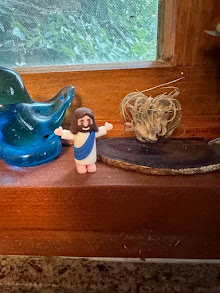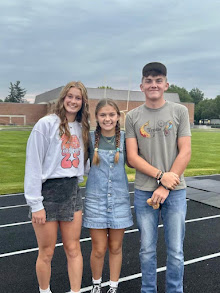
What a trip down the Rabbit Hole this has been. After an absence from my high school Alma mater of nearing 40 years, people have looked me up in the JC Senior High yearbook. Surely I remember? My aunt has penned, printed and bound a memoir of the Renkens of Greenberry Road, with stories I have not heard and photos I have seen hung in my grandmother's rogue's gallery or glued on black scrapbook pages. Blake has an office in the building opened while my mother worked for Farm Bureau; we brought two little girls for their grandma to show off years ago. On Monday, those same girls, their husbands and yet more little girls and boys chattered and roamed like they owned the place so their grandpa could show them off. As a farmer, I have a highly developed sensitivity to cycles and seasons; as a card carrying citizen of a small town, I am a firm believer in the power of lineage, the intertwined network of relations and marriage that constitutes the ties that bind. I don't really have roots, personally, in this town, but my parents, my grandparents, and my great grandparents do, so that's reason enough to dig down, sit back and enjoy the connections and coincidences that result.
Laura has been worrying about my folks' scrapbooks. Any number of them reside in one of the lovely walnut corner cupboards my grandfather crafted for his dining room, now part of the "library" in the old part of the house at Redbarn. Indeed, the front room of the house is the same temperature as the wintry scene outdoors and from the open cupboard emanates the unmistakable smell of aging pages. I satisfy two missions with my request to look at old pictures: I verify the safety and condition of the photo albums and get the opportunity to reminisce about the contents of whichever album surfaces first. Ben is with me on this visit and I figure he is the one farthest removed from my childhood, but before we get a chance to look at the pictures, he has vanished to the old dairy barn and my parents' home styled observatory. From there, Ben and my father progress to the workbenches of the ham shack in the basement. My dad's equipment has a provenance and heritage known only to himself; many of the pieces have received transplants from other machines long laid to rest. I'm certain many would qualify as "one of a kind". I regret that I failed to become the ham operator my father hoped I would become, but Ben got his operator's license, speaks the language and can empathize with the challenges of making these antiques communicate with other antiques.
But while they are gone, my mother pulls a manila envelope from the shelves in the dining room. One of the picture albums covers a summer trip to South Dakota, but the other flips open to a postcard album of Utah and a black and white 5x7 of a smiling group of women and children. Laura and I are there, circa 1964, and the folks pictured are some of my mother's not so near cousins from Eden, Utah. My great aunt Charlotte is in the picture; she was my grandma's sister and black haired well into her old age. Uncle DeLore ran Hereford cattle, irrigated alfalfa, and slept in his recliner after an accident breaking a horse when he was 80. The Salt Lake Valley was this child of the Corn Belt's first experience with the magic of irrigation. Uncle Delore showed us the ditches and the gates; I was fascinated by the logistics of moving water and sharing water. I didn't know at the time, but my father told me the water moved through town as well; on designated days, folks could lift the gates to water their fruit trees and gardens. I felt we were indeed visiting a garden of plenty with the roosters crowing each morning right in town, the sweet cherries fresh from tree to the table and the supper of a rainbow trout, head attached, that I still remember.
My Utah relatives were all Mormon, so we traveled to Salt Lake City to visit the sights. I knew nothing of the history of the Latter day Saints before this visit, nor of their beliefs. The idea of a new prophet, a new book to the Bible, and the like struck me as fantastical, but I was impressed even then by the work ethic of the Latter Day Saints and their appearance of good humor and generosity. I knew my grandfather had various epithets for Mormons as a whole and thus surmised there was more than one side of the story. But it would have taken a less sensitive or romantic soul than I to stay untouched by the story of the pioneers with their handcarts trudging across the mountains, or the women and children freezing through the harsh winter in Florence, Nebraska or the final pronouncement by the implacable Brigham Young that 'This Is the Place'. I may not have been convinced by the theology, but I knew a compelling tale when I heard one!
But, back to the manila envelope. The contents were stories of my mother's grandmother: a copy of her handwritten autobiography, and the stories of her husband's family. My grandmother's name was Berthe Stallings and her parents were Charlotte and Joseph Stallings. Joseph converted to Mormonism in Pennsylvania, left Nauvoo under duress, lost his first wife in Winter Quarters near Council Bluffs, married multiple times, including Charlotte after her husband died. They followed Stephen Markham across the desert to Salt Lake City and arrived in 1850. They are listed as 'pioneers'. Charlotte lived to a ripe old age after innumerable hardships and raising a huge family. Her granddaughter wrote her story separate from her husband's; Joseph's story includes anecdotes of his conversion, but Charlotte's is full of descriptions of her household, her love of chickens, and the practical jokes played by the wives on their husband. It doesn't take much imagination to read between the lines. Charlotte's life is not only bonafide history, but could just as easily be a 400 page pot boiler. I read page after page to my mother, astonished and delighted at the discovery of these ancestors and their very close connection to the history I'd read.
Berthe's life was, no doubt, repeated many times over across the nation. Her husband was chronically ill; she raised three children to adulthood, but lost four or five as children or infants in 1903, 1904, and subsequent years in the early 20th century. The pages chronicle visits to and from relatives, long distance travels to California, including a visit to the Rose Parade. She comes across as a sterling example of every church lady you've met, making doilies, serving on relief committees, serving her community and church. She had "only" five grandchildren, a circumstance endemic to the era her children lived through, but a great contrast to the norm of her parent's.
My mother's experience is the American experience during the latter part of last century. My grandfather worked for the Federal Highway department and they moved several times before settling in Missouri, far away from kith and kin. She seldom saw her cousins, aunts, or uncles. She told me she doesn't know how her mother and father met back there in Utah. I know a little more about her childhood now; I've seen the pictures her parents took of the Christmas tree and the gifts Virginia Ann and Dean received each year. I know their address in Kansas City and the fact that she grew up on the same road as my father only because their home on Greenberry Road was the only suitable house for sale in Jefferson City right after the war.
And now I can tie my parent's albums with the black and white glossies of the Wasatch and the Mormon Tabernacle, the snapshots of little Julie and Laura riding Uncle Delore's pony and playing with kittens to the names in those type written pages from Utah, the names matched with grainy photos of grim faced elders. I am encouraged to keep jotting down the anecdotal evidence of memory and experience, however fuzzy or inaccurate. I'll try to keep the photos from molding and fading into shadow. Someone, sometime, may want to know.















No comments:
Post a Comment